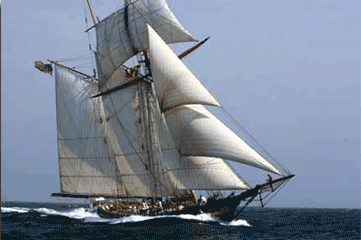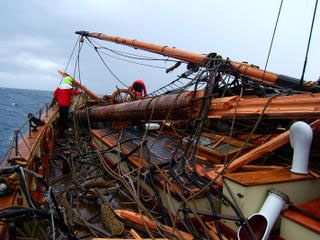The Dismasting of the Pride of Baltimore II
The Pride of Baltimore II, a reproduction of an 1812-era tall ship, was dismasted on September 5 while competing in a race from England to Spain. The Captain’s log on the ship’s official site describes the event this way:
While sailing in a localized squall, the bowsprit cracked and broke at about half its length. Since there are wire rope stays from the bowsprit that secure the foremast, after five minutes in the rough seas the foremast cracked off three feet above the deck The wire rope stays that secure the foremast are also fixed to the mainmast, so it too broke off under the strain of the sea swells about 25 feet above the deck.
Thankfully, no one was injured in the dismasting. Writing on the web site she shares with photographer T.C. “Bhodi” Sheridan, Erin Doak gave the following description of what happened: Tragedy on the Pride.
On Monday at 3:45 pm, the second of two similiar squalls hit Pride II. The first had heavy rains and wind up to 45 knots that made the boat heel till the water was up to the tops of the bulwarks. We quickly struck the jib topsail, but before the sail was completely down, the squall was over. In mild conditions, we reset the sail and continued on. 10 minutes later, the second squall hit and the boat heeled again. I was standing on the starboard side of the quarter deck when I heard a loud crunch of wood and saw the bowsprit, jibboom, and all its sails go tearing off to port. I have never seen the crew rush onto deck so quickly and we all looked to the captain for orders. He called for the striking of the main and we rushed to comply, but it had just barely hit the deck before we heard the noise that sailors never wish to hear, the slow, loud crunching of a wooden mast. Looking forward and up, the foremast twisted to port and fell. Bhodi and I, along with most of the crew were still on the starboard side, and we pushed back against the rail and aft, watching as it fell along the port side of the ship. It collided with the main and the mast broke 30 feet off the deck, and came down with a crash little more than 6 feet from us.
There are lots of great photos on Bhodi and Erin’s Our Pride Adventures weblog, and information about the ongoing repairs to the ship, which is currently docked in Saint Nazaire, France.
Anyone who’s been dismasted remembers the experience vividly. I was aboard my father’s Columbia 52 Victoria when we were dismasted during the 1978 Santa Barbara Island Race. We were approaching the island on the evening of April 1, beating into a 25-knot wind just after dark, when a fitting at the base of the starboard shrouds failed. I was below at the chart table when it happened, and what I heard was not a slow crunch, but a tremendous bang, as Victoria’s aluminum mast snapped about nine feet off the deck. The bang was accompanied by a lurch that threw me onto the cabin sole, and I jumped up and ran up the companionway steps just in time to see the mast and sails settling into the water on the boat’s port side.
There’s a real sense of shock to losing a mast; a sudden, abrupt transition to a new reality. I’ve often thought that a sailor’s education is largely a matter of learning to cope with forces beyond human control, and a dismasting represents an extreme example of that. It’s the sort of lesson that no one would choose to experience willingly, but that certainly sticks with you afterward.
Dismasting-aftermath photo by T.C. “Bhodi” Sheridan, courtesy of www.tallshipadventures.blogspot.com.


September 22nd, 2006 at 4:15 pm
I am a writer of historic fiction; am currently working on a novel in which a galleon (Dutch 1600s) is demasted in a storm – both major sails.
Since they were a long way from land, the temporary/other repairs need to be carried out at sea.
Can you help me understand how that would be done?
i.e. fix a line the the mast that has broken off – to prevent it drifting away in the sea; cut the ropes attached to it; remove and roll up the sails – for further use. Either splice the two pieces together; or over-lap the piedes and band them with iron banding or ropes?
Any help you can provide – or other sources would help?
Greatful thanks in advance.
Kenn
Kenn and Fern Joubert
1492 Fiddick crescent, NANAIMO, BC
Canada V9x1p5.
October 8th, 2006 at 6:15 am
My experience with being dismasted is fairly limited, and probably doesn’t have a lot in common with a 17th-century dutch galleon. For what it’s worth, though:
Typically, the broken mast isn’t going to need to be prevented from drifting away to sea. It’s already going to be attached to the boat by a large number of lines. Especially in an older vessel, which used rope for the standing rigging, there’s going to be an awful tangled mess of lines connecting the wreckage to the boat.
Indeed, in rough sea conditions (often present when it’s been windy enough to be dismasted), the immediate concern is often getting _rid_ of the mast. That’s because a mast plunging up and down in the water alongside the boat, secured loosely to the boat by a lot of lines, represents a serious risk: the mast can damage the hull of the boat, even punching a hole in the boat, leading to a sinking, which is (obviously) much worse than a dismasting.
When our boat was dismasted, we cut the mast free and let it sink as quickly as possible for exactly that reason. It was crunching against the side of the boat every time we rolled on a wave, and doing a lot of damage.
In a situation like the one you describe, where the boat is far from shore and will be dependent on jury-rigging a way to sail to get back to where more-permanent repairs can be made, the crew would certainly prefer to keep the broken mast rather than cutting it free, as long as the conditions allowed that.
But basically your description sounds correct: The crew would want to secure the mast on board (if possible), clear away the tangled sails and rigging, and, when conditions were calm enough to allow for it, erect some kind of jury-rigged mast and rigging to allow for sailing. Basically, the longest spar (or spars) that they have left would be hoisted via lines led from the deck into a vertical position. That’s tricky to do at sea, so in many cases the jury-rigged mast you end up using is significantly smaller than the vessel’s normal mast(s), with the result that the boat has to sail somewhat slowly, “limping” into port for repairs.
They might splice two sections of mast together to get a taller mast, but that falls outside my personal expertise.
The Horatio Hornblower novel “A Ship of the Line” ends with the Lydia being dismasted during a naval battle. That might be an interesting account for you to read, if you haven’t.